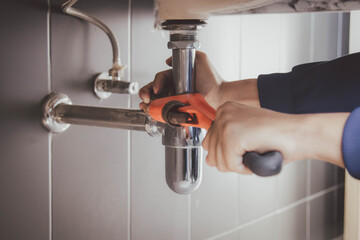There’s nothing that makes a day worse than a clogged drain. A clogged drain may rapidly transform from a small annoyance to a big problem, whether it’s the kitchen sink backing up with dirty dishwater or the shower drain making your morning routine into a standing ankle-deep event. However, you can quickly restore the free flow of the drain with the appropriate method and a few useful pieces of equipment, so don’t allow a bothersome clog to ruin your day.

The first step in effectively unclogging a drain is to accurately identify the issue. Examine the drain closely. Is there anything that can be seen partially obstructing the opening? Or does it appear as though the water is draining incredibly slowly, suggesting a larger blockage farther down the pipe? Determining the precise location of the obstruction will aid in choosing the most effective clearance technique.
If there is an obvious obstruction, things are not too complicated. Put on some rubber gloves and attempt to remove the obstruction manually using pliers, tongs, or even a straightened-out wire coat hanger. Once you’ve cleared the visible blockage, run some hot water down the drain to flush out any lingering bits.
For a deeper clog that’s not visible, you’ll need to bring in the big guns. Gather up these essential tools:
Now you’re ready to tackle the clog head-on.
The good news is that there are some actions you can take to avoid obstructions in the first place, even if clearing a clogged drain is never enjoyable. Installing simple drain covers or hair traps is a good place to start because they will capture food scraps and stray hairs before they have a chance to travel down the pipe.
Making it a practice to regularly flush your drains is also a smart move. After pouring a solution of vinegar and baking soda down each shower, tub, and sink drain and allowing it to sit for a while, boil a kettle of water. This simple DIY cleaner helps break down built-up gunk and residue before it has a chance to fully clog.
Naturally, you should also consider carefully what you’re discarding in the first place. Steer clear of putting anything down the drain that is known to cause clogs, such as cooking fat, coffee grounds, and fibrous vegetables like celery. To help flush the pipes, always run a lot of water while cleaning up after cooking or washing dishes.
You can keep those drains operating properly and save yourself the headache of clearing blockages with a little proactive maintenance and the appropriate troubleshooting skills. Therefore, don’t panic the next time you hear that distinctive gurgling sound or see water collecting around the drain; instead, take your handy plunger and get to work!
Recommended reading: Best Jet Sewer And Drain Cleaners
If you find yourself with a clogged drain and unable to make work, you might need to schedule an appointment with Vossler Pumbing Co. to inspect and carryout technical and professional repair and maintenance on your drains. As plumbing professionals with over 35 years of experience, we have the best and most experienced plumbers to handle any of your plumbing needs. Contact us today at 713-688-2304 for a consultation, or request your estimate right here.
Whatever you’re experiencing, we have the technical expertise to help. Click below to share your information along with any specific details or photos, and we’ll be in touch with you as soon as possible with an estimate.